The following research goal is the development of design decisions for the blockchain-based storage of digital twin data. The digital twin can be deployed in almost every industry and is able to represent any object, being, process or organisation. The resulting benefits are versatile and can encompass a higher transparency and efficiency, cost reduction, or the enabling of completely new functions such as the virtual commissioning. Digital twins do even contribute to a sustainable industrial production as they enable a corresponding reduction of the primary energy emissions of up to eight percent. Due to this substantial added value, digital twins pertain to the top ten strategic technology trends and are expected to reach a market size of over 48 billion USD by 2026.
The existence of digital twins is strongly dependent on its underlying data, for which reason the data storage is of fundamental importance for the operation of this technology. In the past, the digital twin concept mostly relied upon a traditional storage infrastructure in form of databases or clouds. However, digital twins and its data storage face major challenges, e.g., through a
more and more connected world and therefore an increasing number of potential participants and data volume, or as a consequence of growing data security-related risks. Furthermore, potential digital twin use cases entail varying conditions, for which reason alternative storage solutions must be assessed.
The blockchain technology might constitute a possible alternative to realize the storage of digital twin data. Through the novel and nearly unique characteristics such as immutability, decentralisation, or manipulation safety, blockchains could introduce new opportunities to address digital twin use cases. Those characteristics seem relevant at first sight as the application areas
of digital twins become more manifold– especially as the digital twin concept evolves from a descriptive to a rather actionable approach and include more critical data. How the blockchain technology can actually deal with the requirements for the data storage including the abovementioned challenges must therefore be evaluated in order to facilitate
their interplay and potentially achieve their full potential. Hereby, at first the data storage in digital twins must be understood comprehensively to assess the suitability of their deployment.
Inhaltsverzeichnis (Table of Contents)
- INTRODUCTION
- Background
- Problem Statement
- Scope and Delimitation
- Research Method
- Structure of the Thesis
- THEORETICAL BACKGROUND
- Digital Twin
- Origin, Definition, and Characteristics of Digital Twins
- Underlying Technologies
- Data Storage in Digital Twins
- Benefits and Application Areas
- Blockchain
- Foundations of the Blockchain Technology
- Different Blockchain Configurations
- Blockchain-based Digital Twins
- Rationale for Combining Blockchains and Digital Twins
- Benefits
- State of the Art
- METHODOLOGY
- Systematic Literature Review and Classification
- Elaboration of Requirements for the Digital Twin Data Storage
- Review of the Distribution of Data-related Properties
- Expert Interviews
- Evaluation of the Suitability of Blockchain-based Digital Twins
- Development of Design Decisions
- RESEARCH RESULTS
- Taxonomy for the Classification of Data-related Properties in Digital Twins
- Scope
- Data Properties
- Data Collection and Communication
- Storage and Usage
- Requirements for the Data Storage in Digital Twins
- Requirements Derived from Classified Data-related Properties
- Requirements Derived from Industry Expert Interviews
- DISCUSSION
- RQ1: Classification of Data-related Properties in Digital Twins
- RQ2: Requirements for the Data Storage in Digital Twins
- RQ3: Suitability of the Blockchain Technology for Storing Digital Twin Data
- RG: Design Decisions for the Blockchain-based Storage of Digital Twin Data
- Critical Reflexion of the Overall Approach
- CONCLUSION
- Summary
- Limitations
- Outlook
Zielsetzung und Themenschwerpunkte (Objectives and Key Themes)
This master thesis examines the requirements and design decisions for the data storage of blockchain-based digital twins. The work explores the concept of digital twins, their underlying technologies, and the potential benefits of integrating blockchain technology. The research aims to establish a comprehensive understanding of the data storage challenges and opportunities associated with blockchain-based digital twins.
- The concept and characteristics of digital twins
- The foundations and functionalities of blockchain technology
- The rationale for combining blockchain and digital twin technologies
- Requirements for the data storage of blockchain-based digital twins
- Design decisions for a blockchain-based storage solution for digital twin data
Zusammenfassung der Kapitel (Chapter Summaries)
The introduction sets the scene, outlining the background, problem statement, scope, research method, and structure of the thesis. Chapter 2 delves into the theoretical background, defining digital twins, exploring their underlying technologies, examining the role of blockchain, and discussing the potential benefits of combining both technologies.
Chapter 3 details the methodology used in the research, including a systematic literature review and classification of data-related properties, expert interviews, and the evaluation of blockchain technology suitability. Chapter 4 presents the research results, showcasing the taxonomy developed for classifying data-related properties in digital twins and outlining the requirements for the data storage system.
Chapter 5 discusses the research findings, addressing the research questions and discussing the suitability of blockchain technology for digital twin data storage. It also examines the critical reflexions of the overall research approach.
Schlüsselwörter (Keywords)
This master thesis focuses on the data storage of blockchain-based digital twins, exploring concepts such as data-related properties, requirements analysis, blockchain technology, decentralized ledger, data security, data integrity, and data traceability.
- Arbeit zitieren
- Tobias Heinrich (Autor:in), 2022, Blockchain-based Digital Twins. Requirements and Design Decisions for the Data Storage, München, GRIN Verlag, https://www.grin.com/document/1314320



